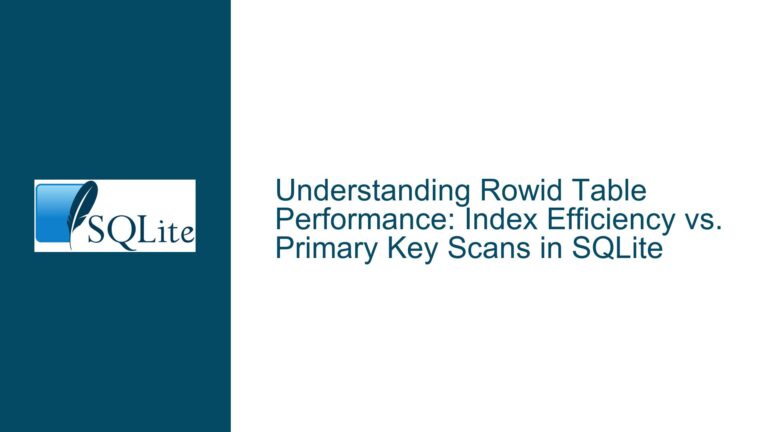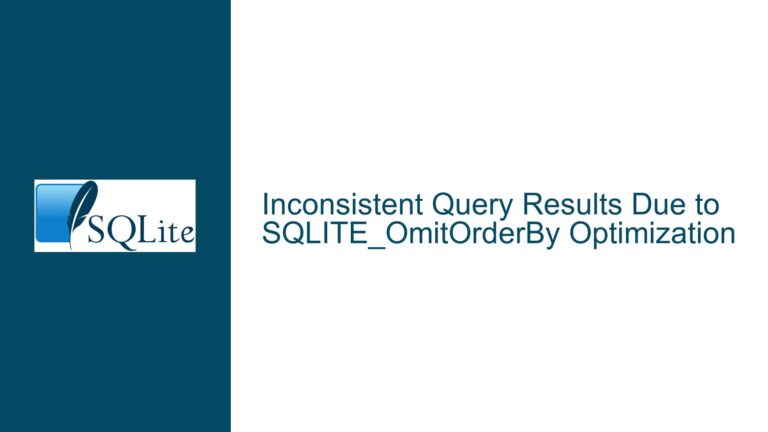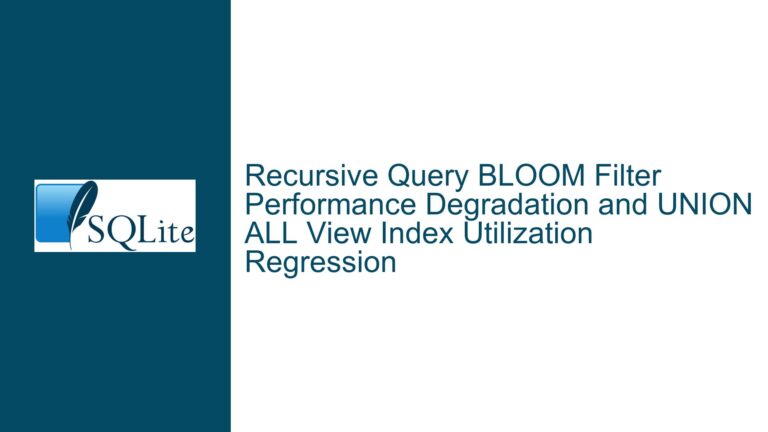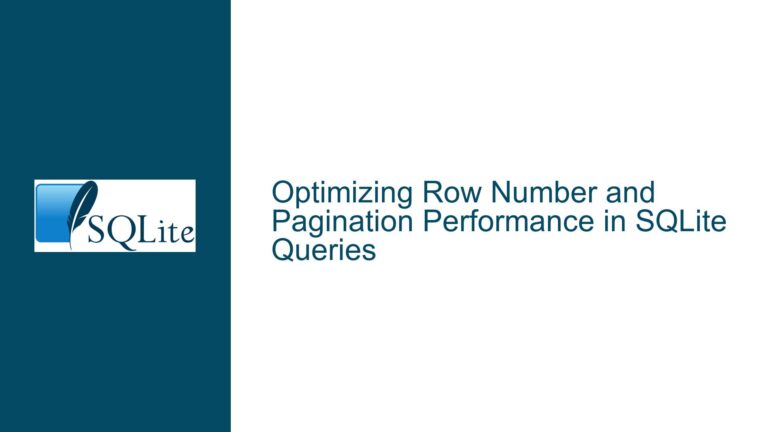Query Planner Regression in Recursive CTE After SQLite 3.44.0
Issue Overview: Query Planner Regression in Recursive CTE with Automatic Indexing
The core issue revolves around a performance regression in SQLite’s query planner when executing recursive Common Table Expressions (CTEs) starting from version 3.44.0. The regression manifests when the query planner decides to use an automatic partial covering index instead of a pre-existing covering index, leading to a significant degradation in query performance. Specifically, the query planner’s decision to re-index a table based on the statistics stored in sqlite_stat1 results in a runtime increase from 1ms to 700ms in some cases.
The problem is particularly noticeable in recursive CTEs that involve joins on indexed columns. The query planner, influenced by the statistics in sqlite_stat1, incorrectly estimates the efficacy of an automatic index over a manually created covering index. This misjudgment causes the planner to generate a suboptimal execution plan, which includes a BLOOM FILTER and an automatic partial covering index, rather than leveraging the existing index.
The issue is reproducible under specific conditions, particularly when the sqlite_stat1 table contains certain statistical data. While the problem was surfaced by changes in SQLite 3.44.0, the root cause traces back to earlier versions, indicating a long-standing optimization flaw in the query planner’s handling of automatic indexes.
Possible Causes: Misestimation of Index Efficacy and Automatic Index Overuse
The root cause of the performance regression lies in the query planner’s over-optimistic estimation of the efficacy of automatic indexes. This misestimation is influenced by the statistical data stored in the sqlite_stat1 table, which the query planner uses to make decisions about index usage. The following factors contribute to the issue:
Statistical Data in
sqlite_stat1: Thesqlite_stat1table contains statistics about the distribution of data in indexed columns. In this case, the statistics for the indexidx__child_of_parent__parent_id__relationare set to500000 29 29, indicating a high selectivity for the indexed columns. However, the query planner misinterprets these statistics, leading it to believe that an automatic index would be more efficient than the existing covering index.Automatic Indexing Mechanism: SQLite’s automatic indexing feature is designed to create temporary indexes on-the-fly when it believes doing so will improve query performance. However, in this scenario, the automatic index is being created unnecessarily, as the existing covering index (
idx__child_of_parent__parent_id__relation) is already optimal for the query. The query planner’s decision to use an automatic index instead of the existing index is the primary cause of the performance regression.Query Planner Weight Adjustments in SQLite 3.44.0: The issue was brought to the surface by changes in the query planner’s weighting algorithm in SQLite 3.44.0. These changes, intended to improve overall query performance, inadvertently exacerbated the misestimation of index efficacy in certain scenarios, particularly those involving recursive CTEs.
Historical Optimization Flaw: The underlying issue is not new; it traces back to SQLite 3.8.8, where similar misestimations of index efficacy were present. However, the changes in SQLite 3.44.0 made the problem more pronounced, leading to the observed performance regression.
Troubleshooting Steps, Solutions & Fixes: Addressing the Query Planner Regression
To address the query planner regression and restore optimal query performance, the following steps and solutions can be implemented:
Disable Automatic Indexing: The most immediate and effective workaround is to disable automatic indexing using the
PRAGMA automatic_index=OFF;command. This prevents the query planner from creating automatic indexes and forces it to use the existing covering index (idx__child_of_parent__parent_id__relation). This solution is recommended for users experiencing the performance regression, as it provides an immediate fix without requiring changes to the database schema or query structure.Review and Adjust
sqlite_stat1Statistics: The statistical data insqlite_stat1plays a critical role in the query planner’s decision-making process. Reviewing and adjusting these statistics can help mitigate the issue. For example, modifying the statistics for theidx__child_of_parent__parent_id__relationindex to better reflect the actual data distribution may improve the query planner’s index selection. However, this approach requires careful analysis and testing to ensure that the adjusted statistics do not introduce new performance issues.Optimize Query Structure: In some cases, restructuring the query can help the query planner make better decisions. For example, breaking down the recursive CTE into smaller, more manageable parts or using alternative query constructs may reduce the likelihood of the query planner choosing an automatic index. However, this approach requires a deep understanding of the query’s logic and may not always be feasible.
Monitor and Analyze Query Plans: Regularly monitoring and analyzing query plans using the
EXPLAIN QUERY PLANcommand can help identify potential performance regressions early. By understanding how the query planner is executing queries, developers can proactively address issues before they impact production systems. This practice is particularly important when upgrading to new versions of SQLite, as changes in the query planner’s behavior may introduce new performance challenges.Upgrade to Future SQLite Releases: The SQLite development team has acknowledged the issue and plans to address it in a future release. Upgrading to a version that includes the fix will provide a long-term solution to the performance regression. In the meantime, users should stay informed about updates and plan for the upgrade when the fix becomes available.
Consider Alternative Indexing Strategies: In some cases, alternative indexing strategies may be more effective than relying on the query planner’s automatic indexing. For example, creating additional covering indexes or using composite indexes can provide the query planner with more options and reduce the likelihood of suboptimal index selection. However, this approach requires careful consideration of the database’s schema and query patterns to avoid introducing unnecessary overhead.
Evaluate Database Design: The performance regression highlights the importance of thoughtful database design. Ensuring that tables and indexes are designed to support the most common query patterns can reduce the likelihood of performance issues. Regularly reviewing and optimizing the database schema can help maintain optimal query performance over time.
Engage with the SQLite Community: The SQLite community is a valuable resource for troubleshooting and optimizing database performance. Engaging with the community through forums, mailing lists, and other channels can provide insights and solutions to complex performance issues. Sharing experiences and learning from others can help developers stay ahead of potential challenges.
By following these troubleshooting steps and implementing the recommended solutions, developers can address the query planner regression and restore optimal query performance in SQLite. The key is to understand the underlying causes of the issue, leverage available tools and techniques, and stay informed about updates and best practices. With careful attention to detail and a proactive approach to database optimization, developers can ensure that their SQLite databases continue to perform efficiently and reliably.






